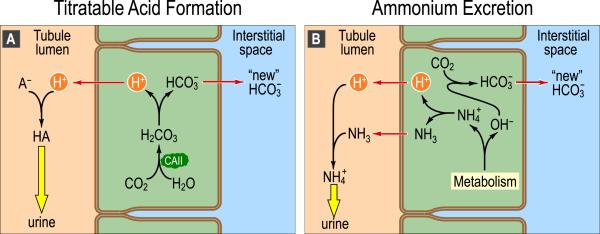Fig. 4.
Basic cellular mechanism of generation of “new” HCO3− . A: Titratable acid formation. At various sites along the nephron, the tubule cells secrete H+ into the lumen. One result is the titration of weak bases (A−), filtered from the blood in the glomerulus, to form their conjugate weak acids (HA). In parallel, a new HCO3− appears in the interstitial space and then in the blood. B: Ammonium excretion. In the proximal tubule, cells generate ammonia (NH3) de novo from the amino acids glutamine and glutamate. In the lumen, secreted H+ titrates this NH3 to form ammonium (NH4+). In parallel, a new HCO3− appears in the interstitial space and then in the blood. Because the maximum free [H+] of the urine is only ~4 × 105 M (pH ~4.4), the urinary excretion of H+ in the form of HA and NH4+–which are typically present at mM level–allows the kidney to eliminate far more acid than it could if all of the secreted protons were excreted in the form of free H+. Modified from Fig. 39-2B and C in Medical Physiology, 2nd Edition Updated Edition, edited by WF Boron and EL Boulpaep, Philadelphia: Elsevier, 2012.

